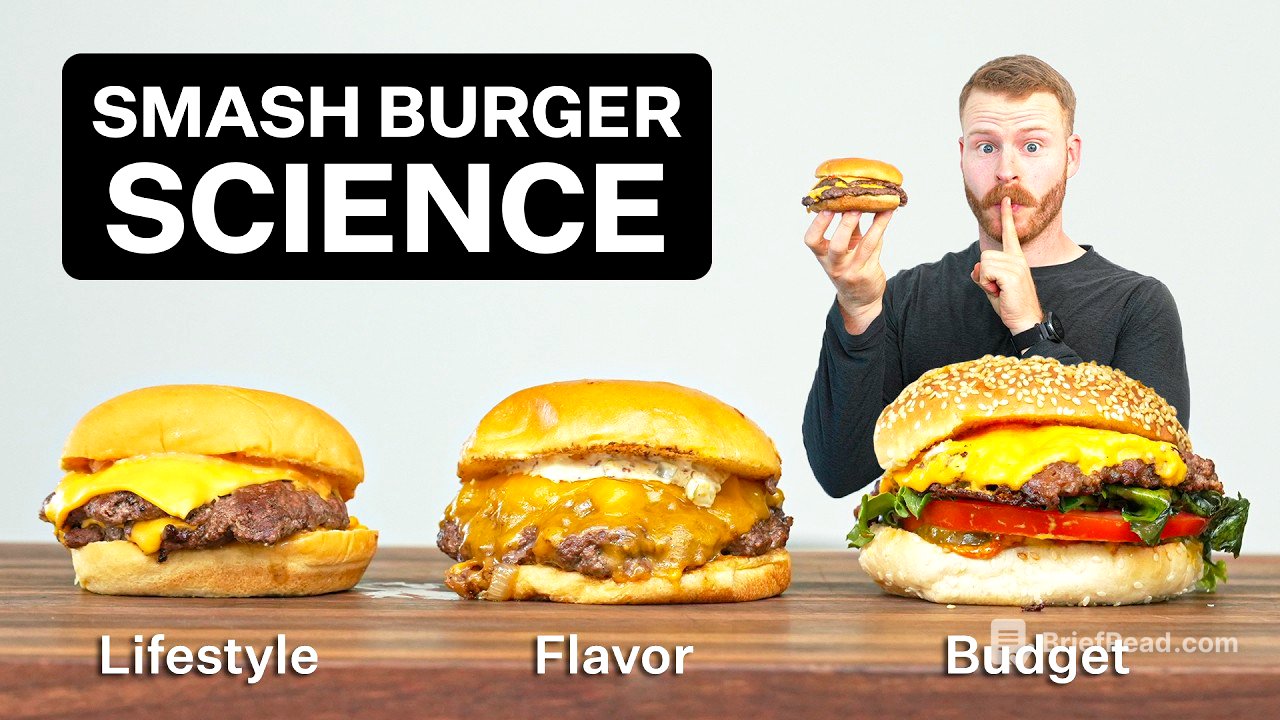TLDR;
This video explores the science behind making the perfect Smashburger, focusing on how different ingredients, smashing techniques, and toppings affect the final product. It covers ground beef selection based on budget, flavor, and calories, and examines how water, fat, and protein content impact the cooking process. The video also tests various smashing methods to achieve optimal texture and browning, and it concludes with three unique Smashburger builds tailored to different preferences and nutritional goals.
- Ground beef selection impacts flavor, juiciness, and calorie count.
- Smashing technique affects browning, texture, and moisture retention.
- Understanding the science helps customize Smashburgers to personal preferences.
Intro [0:00]
The video introduces the concept of Smashburgers and highlights the lack of detailed explanations regarding the food science behind their appeal. It promises to break down the key elements that contribute to a great Smashburger through a series of tests. These tests include comparing different types of ground beef, exploring various smashing techniques, and assembling three distinct Smashburger builds. The goal is to provide viewers with the knowledge to create their ideal Smashburger. The video is sponsored by Maiden, whose carbon steel griddle is used for cooking.
How to choose the right ground beef [1:58]
Navigating the ground beef options at a grocery store can be overwhelming due to the numerous variables, including cow breeds, diets, cuts of beef, fat percentages, and packaging methods. The key question to ask when buying ground beef is what you are optimizing for, such as budget, flavor, or calories. Three types of ground beef are tested: a generic 73/27 blend, an 80/20 grass-fed blend with beef trim, liver, and heart, and a leaner 93/7 grass-fed beef. The tests track shrinkage, crust formation, taste, aroma, texture, chewiness, and juiciness. The core molecules in ground beef—water, fat, and protein—are examined to understand their roles in cooking. Water evaporates and affects juiciness, fat contributes to juiciness and flavor by acting as a thermal conductor and solvent for aroma molecules, and protein provides structure and browning through the Maillard reaction. The shrinkage observed in the patties is a result of both water evaporation and fat melting.
Part 2: How thick or thin should you smash the beef? [10:10]
The video shifts focus to how the smashing technique affects the final Smashburger, keeping the ground beef consistent (80/20 ground chuck). Three methods are compared: an ultra-thin patty, two thin patties, and a half-smash burger. The Maillard reaction, a chemical reaction between amino acids and reducing sugars, is crucial for achieving deep browning and complex aromas at high heat (above 300°F). Smashing increases the surface area in contact with the hot pan, facilitating edge-to-edge browning. Preheating the pan to 450°F is recommended to counteract the temperature drop when the cold beef is added. The ultra-thin patty maximizes surface area but results in less juiciness due to more water and fat loss. The half-smash burger retains more fat and water, resulting in a juicier patty but less surface area for browning. The double patty smash burger offers similar surface area to the ultra-thin patty and allows for layering cheese and toppings between the patties.
Part 3: What is the best burger bun and toppings? [16:30]
The video explores how different combinations of ground beef, smashing techniques, buns, and toppings can create unique Smashburger builds. Three distinct Smashburgers are assembled: a cheddar and onion Smashburger using 80/20 grass-fed beef, a half-smash technique, fried onions, sharp cheddar, and a tangy mayo-mustard-pickle sauce; a classic diner-style Smashburger using 73/27 store-bought beef, a thin and wide patty, American cheese, a sesame seed roll, ketchup, mustard, bread and butter pickles, red onions, tomato, and lettuce; and a macro-friendly Smashburger using 93/7 lean beef, two patties, lower-fat cheese, a ketchup-mustard-mayo sauce, raw onions, and smoked paprika on a potato roll. Each burger is designed to cater to different preferences, whether it's bold flavor, nostalgic taste, or lower calories. The video emphasizes that understanding the science behind each choice allows for creating a Smashburger that fits specific needs and situations.








